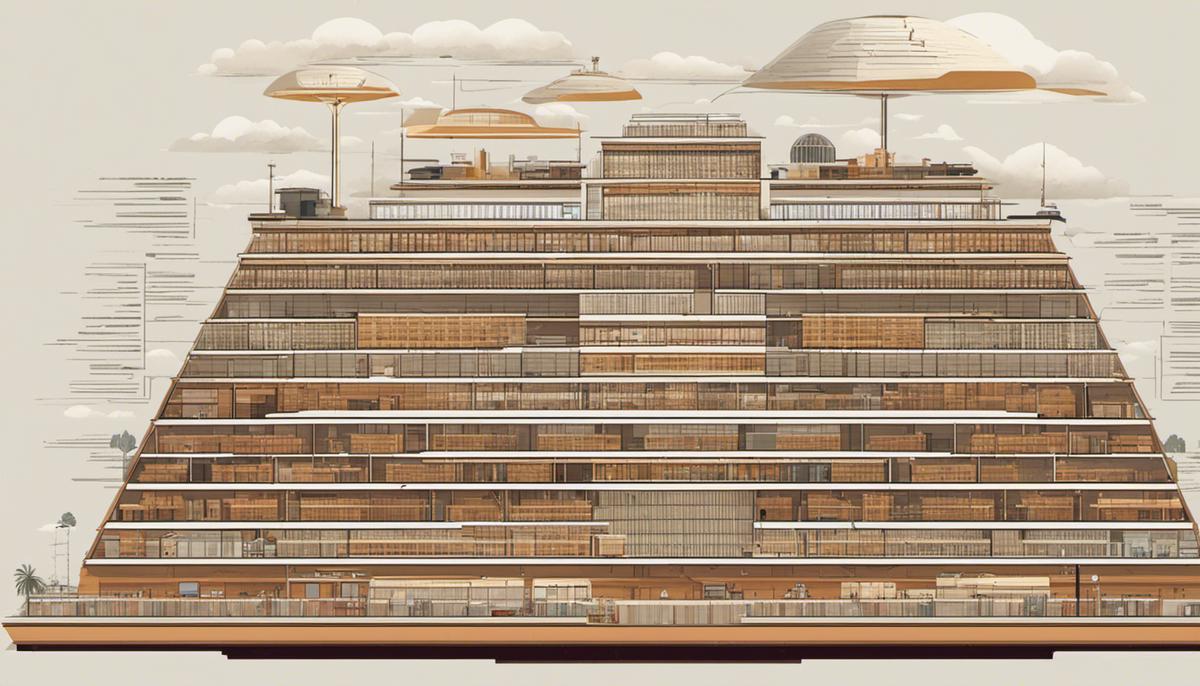As societies evolve, so do their structures and systems, a proliferation of which is bureaucratic organizations. Understanding the concrete architecture and intricate dynamics of a bureaucratic organization begins with a glimpse into their defining features—with strict hierarchy, division of labor, and formal rules and regulations acting as its structural pillars. The practical implications of bureaucracy don’t stop at just order and efficiency; they unpack both significant benefits and noted limitations. These ideas, nurtured by key theorists, ground us in a comprehensive perspective.
Structure and Features of a Bureaucratic Organization
Overview of Bureaucratic Organizations
Bureaucratic organizations are essentially structured networks in which authority and decision-making responsibilities are distributed according to a specific hierarchical system. This system, structured based on ranks or levels, allows for a clear chain of command and delineation of responsibilities across different ranks. At the top of such a hierarchy, higher-level executives or officials often dictate policies and strategies, which gradually filter down the ranks to the operating level officials who execute those policies.
Role of Hierarchy in Bureaucratic Organizations
The strict hierarchy in a bureaucratic organization ensures that there is a clear chain of command. It promotes discipline and the effective implementation of policies across different ranks. Every person within this hierarchy has a defined role and is accountable to a higher-ranking individual. This clear chain of command simplifies work complexities, enhances coordination, and improves overall organizational efficiency.
Division of Labor
In the context of a bureaucratic organization, the division of labor refers to the partitioning of large tasks into smaller tasks to allow for greater-efficiency and accuracy in their execution. Each worker becomes an expert in whatever task they’re assigned to, leading to time and cost efficiencies. This functional specialization enhances individuals’ proficiency and knowledge in their specific field of work.
Formal Rules and Regulations
Formal rules and regulations are the backbone of a bureaucratic organization. These rules provide a structure and a predictable framework for decision-making. These rules are written down and standardized, and every member of the bureaucratic organization is expected to follow them. Such a formal system helps in maintaining integrity, impartiality, and consistency in the performance of duties.
Historical Context of Bureaucratic Organizations
The concept of bureaucratic organizations was initially conceived by a 19th-century German sociologist, Max Weber. Weber argued that bureaucratic organizations are the most rational and efficient form of an organization. He stated that such organizations promote order, fairness, and efficiency. His work laid the foundations for modern theories of bureaucracy and administration.
Champions of Bureaucratic Organizations
Bureaucratic organizations have numerous proponents, with Max Weber being one of the forefront. Other significant supporters include Frederick Taylor, renowned for his theories on scientific management. Taylor emphasized the benefits of labor division. Alongside him, Henri Fayol pushed administrative management theories that enhanced understanding of the significance of hierarchy and formal rules and regulations within bureaucratic establishments.

Advantages and Disadvantages of Bureaucracy
Advantages Offered by a Bureaucratic Structure
A critical advantage of bureaucratic structures in any organization is its innate capacity to maintain order on a consistent basis. Bureaucracy fosters highly standard operating procedures that bolster both predictability and consistency across the organization. Individuals within such a system have clearly delineated roles and responsibilities, thereby reducing any potential possibility of confusion or misunderstanding. This highly organized approach streamlines work processes, promoting a methodical progression towards achieving organizational goals.
Moreover, bureaucratic organization improves overall efficiency. The well-defined authority lines in these structures ensure the prompt and accurate coordination of all actions and decisions. The hierarchical structure facilitates each decision or action to go through a systematic series of verification and approval, effectively minimizing the likelihood of errors. In the grand scheme, this type of structure paves a clear path for informed decision-making processes, thereby expediting and enhancing the accuracy of organizational operations.
Potential Drawbacks of Bureaucratic Structures
Contrary to the benefits, the bureaucratic structure is often criticized for its rigidness. The overemphasis on rules and regulations may create an overly rigid environment, limiting the flexibility needed for quick decision-making in a rapidly changing business environment. The rigidity can also stifle initiative and innovation, leading to complacency among employees.
Bureaucratic structures are often perceived as limiting creativity and innovative ideas. Bureaucracy tends to favour standardization and uniformity, often at the expense of creativity and innovation. In a bureaucratic culture, employees are required to follow the established rules and procedures strictly, potentially stifling their ability to think outside the box and come up with innovative solutions.
The hierarchical nature of bureaucratic structures in organizations can also lead to power abuses. Given the rigid hierarchy, there is the potential for senior management to exploit their position for personal gain. The lack of transparency and accountability that can often characterize bureaucratic systems can make it easier for such abuses of power to occur.
Lastly, one significant challenge is the often slow decision-making process. The lengthy approval processes can make it difficult for organizations to respond swiftly to changes in the market. In today’s fast-paced business environment, agility is paramount. Thus, a bureaucratic structure might hinder an organization’s ability to remain competitive and adaptive.
Understanding that bureaucratic structures can offer certain benefits such as promoting organization and enhancing productivity is necessary. However, it’s equally crucial to be mindful of inherent disadvantages tied to this kind of system; limitations that include inflexibility, restricted creativity, a likelihood for misuse of power, and a slower decision-making process. Therefore, the challenge for organizations lies in utilizing the beneficial aspects of bureaucracy whilst minimizing its potential shortcomings.

Bureaucracy in Practice: Real World Examples
A Glimpse into a Governmental Bureaucracy: The Internal Revenue Service
The Internal Revenue Service (IRS), a governmental bureaucracy, plays a significant role in the lives of U.S. residents. This bureaucracy is structured into several departments each focusing on unique aspects including enforcing regulations, interpreting the tax code, processing tax forms, and offering taxpayer services. The decisions made by the IRS directly influence both individuals and businesses, with the authority to enforce penalties, conduct audits, and initiate collection activities. Despite the IRS often conjuring a negative image due to its stringent law enforcement role, it’s important to acknowledge the essential services it provides. These include taxpayer education, facilitation of dispute resolution, and providing platforms for simplified tax form submissions.
Corporate Bureaucracy: The General Motors Company
The General Motors Company provides a tangible example of a corporate bureaucracy. Its hierarchical structure consists of several levels, from front-line employees to middle management and senior executives, each with specific roles and responsibilities. The bureaucratic nature of GM helps maintain order and consistency in its operations, ensuring that decisions are taken in a systematic manner. However, this can sometimes lead to inefficiency and sluggish responses to market changes, as decisions must pass through several levels of approval before being implemented.
Educational Bureaucracy: Harvard University
Harvard University serves as an example of bureaucracy in the educational sector. Its structure includes various departments and offices such as admissions, student affairs, and academic departments, each of which follows specific procedures and policies. This system ensures the equitable treatment of students and staff, upholds academic standards, and helps maintain order within the institution. Conversely, bureaucracy in such a large institution can lead to issues such as slow administrative processes and difficulty in making swift changes to policy or curriculum.
Non-Profit Bureaucracy: The American Red Cross
The American Red Cross, a non-profit organization, demonstrates how bureaucracy operates within the humanitarian realm. The organization’s structure comprises various levels and departments, including disaster response, health and safety training, and biomed services. This systematization helps to maintain order, ensures accountability and transparency, and allows for successful nationwide coordination of resources and aid. However, criticisms include potential for inefficiencies, as well as hardened bureaucratic procedures that may hinder rapid responses or flexible resource allocation.
The foundation of any bureaucratic organization lies in its structured system where specific departments and roles are designed to execute tasks in a consistent manner for the accomplishment of collective goals. Though this systematic approach can sometimes be criticized for certain inefficiencies and inflexible procedures, it does provide valuable benefits like maintaining order, encouraging transparency, and creating accountability across a wide variety of sectors.

Transformation of Bureaucracy in the Digital Age
The Transformation of Bureaucracy in the Digital Age
While the core of bureaucracy relies on time-tested principles of hierarchy and division of labor, these norms are evolving in the face of technological advancements. The digital revolution has sparked changes in methodical bureaucratic processes, replacing the linear, paper-based, and slow procedures with dynamic, digitized methodologies and instantaneous modes of communication. Traditional bureaucratic staples such as paperwork, decision points, and checkpoints are now shifting towards full automation, paving the way for a new breed of digital bureaucracy.
Digital Bureaucracy
Digital bureaucracy refers to the application of digital technologies to bureaucratic processes. This includes the digitization of previously paper-based processes and employing advanced technology such as Big Data analytics, AI, and machine learning to enhance efficiency and effectiveness. Examples include the use of online forms and portals for public services that expedite processing times, reduce errors, and make services more accessible. Digital bureaucracy often aims to deliver public services in an efficient, seamless fashion that matches the digital experiences provided by the private sector.
E-governance
E-governance is another significant concept in the current bureaucratic landscape. It refers to the practice of using information and communication technologies to improve the activities of public sector organizations. By streamlining and automating processes, e-governance can facilitate easier access to information, foster greater civic engagement, and enhance government responsiveness. For instance, government websites and social media accounts provide direct communication channels between governments and their citizens, giving rise to more direct and instant public participation and feedback.
Technology’s Impact on Bureaucracy
The impact of technological advancements on traditional bureaucratic structures has been profound. On one hand, technology has the potential to reduce bureaucratic inefficiencies and enhance the quality of public services. For example, automated work processes can minimize routine clerical tasks and eradicate human errors, leaving public servants with more time to address complex issues requiring human judgment.
On the other hand, digitalization also brings along a set of challenges. For instance, the transition to a digital bureaucracy often demands substantial changes in organizational culture and processes. As public sector institutions are often risk-averse, such changes can be difficult to implement.
Moreover, evolving privacy and security concerns add complexity to digital transformation efforts. Protecting sensitive data in a highly digital bureaucratic environment requires sophisticated technological measures, comprehensive regulations, and well-informed personnel. These new challenges necessitate an adaptation of the bureaucratic machine – a restructuring of rules, roles, and relationships to maintain control while also promoting innovation and progress.
The intersection of bureaucracy and technology is complex and multifaceted, transforming over time as technology evolves. With continuing advancements, the traditional bureaucratic model will continue to adapt and transform, forging a new digital path for organizational structure and performance.

However, bureaucratic structures are not static, particularly in an era defined by rapid technological advancements and digital transformation. Concepts like e-governance and digital bureaucracy offers insights into the adaptive nature of bureaucratic organizations amidst these changes and also raises interesting questions on what the future of bureaucracy might look like. Could they maintain their foundational principles while assimilating digital changes or would they evoke a new structural paradigm? Whatever the future holds, bureaucracy, in essence, continues to interweave into the socio-economic fabric of our societies.

